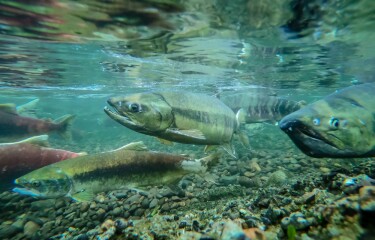A recent literature review that analyzed over 200 studies focusing on the release of hatchery salmonids, which include species such as salmon, trout, and char, revealed hatchery releases often adversely affect marine and freshwater wild salmonid populations.
The research, “A global synthesis of peer-reviewed research on the effects of hatchery salmonids on wild salmonids," which appeared in Fisheries Management and Ecology, scoured over 50 years’ worth of publications published between 1970 and 2021. Over half the publications studied fisheries in the United States, with other countries studied including Canada, France, Spain, and Norway. The research primarily focused on the effects releases have on 15 species, such as brown trout, steelhead trout, Chinook salmon, and Atlantic salmon.
While the release of hatchery salmonids typically lead to an increase in stock abundance and overall aquaculture successes, those gains are often counterbalanced by genetic and ecological disruptions to wild populations. These disruptions are due to the fact that hatchery fish compete for the same resources and reproductive opportunities as wild salmonids and can introduce exponentially harmful maladaptive behaviors in future generations.
“Wild and hatchery fish are not the same creatures. Wild salmonids embody unique genetic characteristics and incredible ecological strategies developed over long evolutionary histories, and hatchery fish can erode these adaptations and reduce the resiliency of wild populations,” Helen Neville, one of the study co-author's and a senior scientist at Arlington, Virginia, U.S.A.-based nonprofit Trout Unlimited, said.
There are many bodies of water where hatchery fish now make up large swaths of overall populations. For example, over five billion hatchery fish are annually released into the Pacific Ocean, with over 40 percent of the salmon biomass in the Pacific now comprised of hatchery fish. Neville said these releases are helpful in certain instances but should not be used as a blanket solution to increasing salmonid populations.
“Hatcheries will remain a key part of fishery management in many watersheds, especially in places where habitat is degraded or populations are on the brink of extinction and to support critical needs like tribal rights to harvest,” Neville said. “Where these programs are used, managers should look to the best available science to guide the operation of these programs to ensure they meet the highest standards possible to reduce the risk to wild salmonids.”
Neville said though the raising and release of hatchery fish provides some benefits, such as subsidizing fisheries, mitigating habitat loss and overexploitation, and rebuilding depleted populations of wild salmonids, the risk of doing so can often outweigh the benefits. Namely, even when broodstock directly stem from a wild population, genetic issues such as inbreeding and reduced resistance to parasitic infections still arise.
“From that very basic genetic perspective, even if you’ve built your broodstock out to thousands of individuals, they’re all genetically representative of that first group that increasingly differentiates from the wild population over time,” Neville said. “Then, add strong selection for domestication in a hatchery, where individuals that perform well in the artificial hatchery environment do better in that setting but perform more poorly in the wild, and you end up with quite a different fish.”
Wild salmonids demonstrate substantial resilience to disease, but adapting rapidly to a hatchery environment inevitably leads to the ....
Photo courtesy of Christina Dutkowski/Shutterstock








